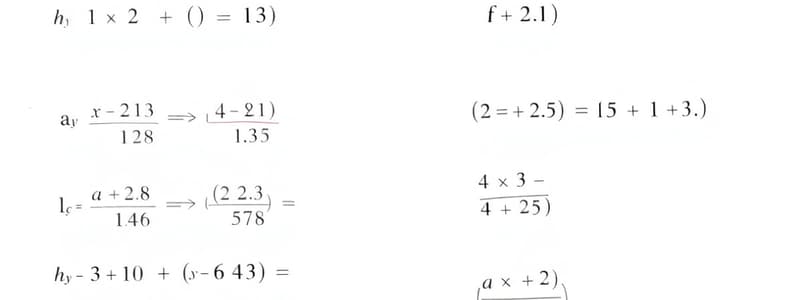Podcast
Questions and Answers
What is the first step in completing the square for the expression $ax^2 + bx + c$ when $a \neq 1$?
What is the first step in completing the square for the expression $ax^2 + bx + c$ when $a \neq 1$?
- Rewrite $bx$ as $\frac{b}{2}$
- Add and subtract $\left(\frac{b}{2}\right)^2$
- Factor the expression directly
- Divide all terms by $a$ (correct)
Which expression represents a perfect square trinomial?
Which expression represents a perfect square trinomial?
- $x^2 - 4x + 4$ (correct)
- $x^2 + 2x + 1$ (correct)
- $x^2 - 5x + 6$
- $3x^2 + 18x + 27$
What defines a general trinomial?
What defines a general trinomial?
- It can be factored without grouping.
- It is always a perfect square.
- It has a leading coefficient of 1.
- It follows the form $ax^2 + bx + c$ with $a \neq 1$. (correct)
When factoring the expression $x^2 - 9$ using the difference of squares, what are the factors?
When factoring the expression $x^2 - 9$ using the difference of squares, what are the factors?
In the expression $x^2 + 6x + 9$, what factors can be identified?
In the expression $x^2 + 6x + 9$, what factors can be identified?
What is the product of the coefficients in the trinomial $3x^2 + 11x + 6$?
What is the product of the coefficients in the trinomial $3x^2 + 11x + 6$?
Which method is NOT typically used for factoring a quadratic trinomial?
Which method is NOT typically used for factoring a quadratic trinomial?
How can the expression $x^2 + 10x + 25$ be restructured?
How can the expression $x^2 + 10x + 25$ be restructured?
For the quadratic formula, what is the discriminant used for?
For the quadratic formula, what is the discriminant used for?
What is the correct format for a perfect square trinomial?
What is the correct format for a perfect square trinomial?
Flashcards are hidden until you start studying
Study Notes
Factoring Techniques
- Standard Form: A quadratic trinomial is usually in the form ( ax^2 + bx + c ).
- Common Methods:
- Finding Factors: Look for two numbers that multiply to ( ac ) (product of ( a ) and ( c )) and add to ( b ) (coefficient of ( x )).
- Grouping: Split the middle term based on the factors found and group terms for common factors.
- Trial and Error: Test possible factor pairs for ( a ) and ( c ).
- Using Formulas: Apply the quadratic formula if necessary for complex cases.
Types Of Trinomials
-
Perfect Square Trinomials:
- Form: ( (x + a)^2 = x^2 + 2ax + a^2 ) or ( (x - a)^2 = x^2 - 2ax + a^2 )
- Criteria: The first and last terms are perfect squares, and the middle term is twice the product of the square roots.
-
Difference of Squares:
- Form: ( a^2 - b^2 = (a - b)(a + b) )
- Not a trinomial, but often encountered in factoring larger expressions.
-
General Trinomials:
- Form: ( ax^2 + bx + c ) where ( a \neq 1 )
- Requires special techniques like grouping.
-
Quadratic with Leading Coefficient of 1:
- Form: ( x^2 + bx + c )
- Easier to factor since ( a = 1 ).
Completing The Square
- Purpose: Transform a quadratic trinomial into a perfect square trinomial.
- Steps:
- Start with ( ax^2 + bx + c ).
- If ( a \neq 1 ), divide all terms by ( a ).
- Rewrite ( bx ) as ( \frac{b}{2} ) and square it: ( \left(\frac{b}{2}\right)^2 ).
- Add and subtract this square inside the equation.
- Factor the resulting perfect square trinomial and adjust the constant term accordingly.
- Result: The expression is rewritten as ( a(x + \frac{b}{2a})^2 + (c - \frac{b^2}{4a}) ).
Factoring Techniques
- Quadratic trinomials often take the standard form ( ax^2 + bx + c ).
- Identify factors by finding two numbers that multiply to ( ac ) and add to ( b ).
- Use grouping by splitting the middle term based on the identified factors.
- Employ trial and error by testing various factor pairs of ( a ) and ( c ).
- Utilize the quadratic formula for complex expressions when necessary.
Types Of Trinomials
- Perfect Square Trinomials:
- Expressed as ( (x + a)^2 = x^2 + 2ax + a^2 ) or ( (x - a)^2 = x^2 - 2ax + a^2 ).
- Features perfect squares for the first and last terms with the middle term being double the product of the square roots.
- Difference of Squares:
- Formulated as ( a^2 - b^2 = (a - b)(a + b) ).
- Not a trinomial but relevant in factoring larger polynomial expressions.
- General Trinomials:
- Shown as ( ax^2 + bx + c ) where ( a \neq 1 ).
- Factoring requires specialized techniques like grouping.
- Quadratic with Leading Coefficient of 1:
- Expression ( x^2 + bx + c ) where ( a = 1 ) simplifies the factoring process.
Completing The Square
- Objective: Convert a quadratic trinomial into a perfect square trinomial.
- Procedure:
- Start with the quadratic trinomial ( ax^2 + bx + c ).
- If ( a \neq 1 ), divide every term by ( a ).
- Recast ( bx ) to ( \frac{b}{2} ) and square it: ( \left(\frac{b}{2}\right)^2 ).
- Add and subtract this squared term within the equation.
- Factor the outcome into a perfect square trinomial while adjusting the constant term.
- Final Form: The expression is reformulated as ( a(x + \frac{b}{2a})^2 + (c - \frac{b^2}{4a}) ).
Studying That Suits You
Use AI to generate personalized quizzes and flashcards to suit your learning preferences.




